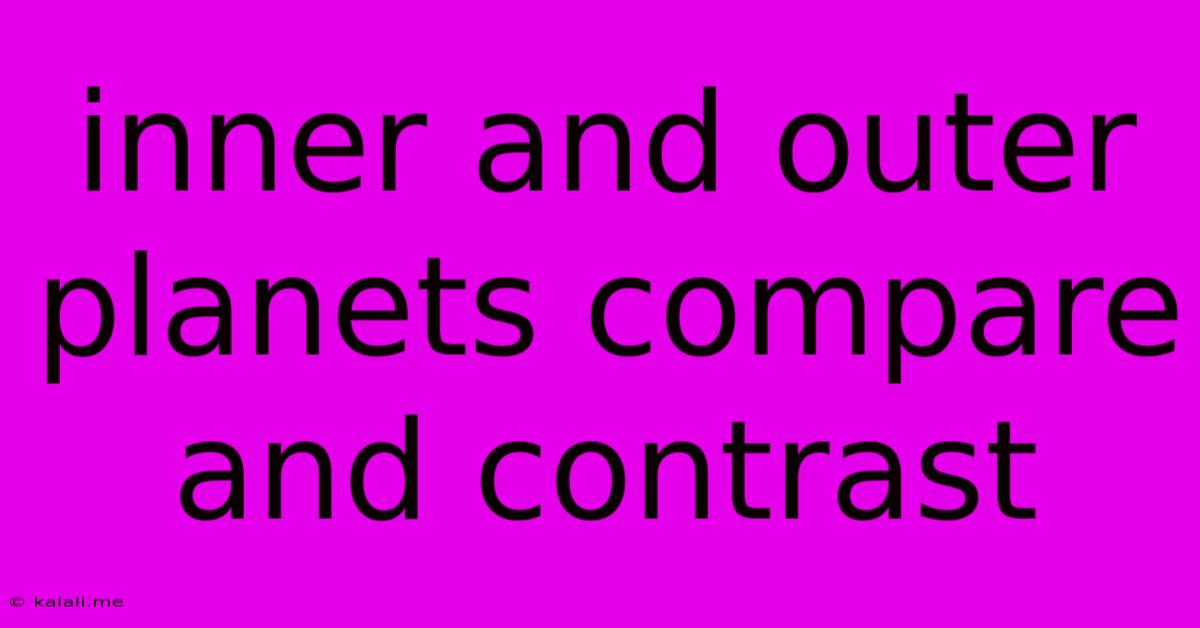Inner And Outer Planets Compare And Contrast
Kalali
May 09, 2025 · 3 min read

Table of Contents
Inner vs. Outer Planets: A Comparative Look at Our Solar System
Our solar system, a captivating celestial neighborhood, is home to a diverse array of planets, each with its own unique characteristics. Broadly categorized into inner and outer planets, these celestial bodies offer a fascinating study in contrasts and similarities. This article delves into the key differences and shared traits between these two planetary groups, providing a comprehensive overview for both novice and experienced astronomy enthusiasts.
What are Inner Planets?
The inner planets, also known as the terrestrial planets, are Mercury, Venus, Earth, and Mars. They are characterized by their relatively small size, rocky composition, high density, and slow rotation. They reside closer to the Sun, resulting in significantly warmer surface temperatures compared to their outer counterparts. These planets are relatively close together, orbiting within a relatively compact region of the solar system.
What are Outer Planets?
The outer planets, also known as the gas giants or Jovian planets, comprise Jupiter, Saturn, Uranus, and Neptune. Unlike their inner counterparts, these planets are massive, gaseous, and low in density. Their atmospheres are composed primarily of hydrogen and helium, with trace amounts of other gases and ices. They also boast a significant number of moons and rings. The vast distances between these planets and the Sun result in significantly colder temperatures.
Key Differences Between Inner and Outer Planets:
| Feature | Inner Planets (Terrestrial) | Outer Planets (Gas Giants) |
|---|---|---|
| Size & Mass | Relatively small and less massive | Extremely large and massive |
| Composition | Primarily rocky, with metallic cores | Primarily gas (hydrogen and helium), with possible rocky cores |
| Density | High density | Low density |
| Atmosphere | Thin or nonexistent atmospheres (except Earth) | Thick, extensive atmospheres |
| Rotation | Relatively slow rotation | Relatively fast rotation |
| Moons | Few or no moons | Numerous moons |
| Rings | No rings | Most have extensive ring systems |
| Surface | Solid surface (except partially molten Venus) | No solid surface; fluid interiors |
| Temperature | Relatively high surface temperatures | Extremely low surface temperatures |
Similarities Between Inner and Outer Planets:
Despite their significant differences, the inner and outer planets share some commonalities:
- Orbit the Sun: All planets in our solar system, both inner and outer, orbit the Sun in an elliptical path.
- Gravitational Influence: All planets exert gravitational influence on other celestial bodies within the solar system. This influences their orbits and even the formation of moons.
- Formation from Solar Nebula: All planets formed from the same swirling cloud of gas and dust – the solar nebula – billions of years ago.
Exploring Further: Specific Planetary Features
While this comparison provides a general overview, each planet possesses unique characteristics. For example, Venus has a runaway greenhouse effect resulting in scorching temperatures. Earth boasts a thriving biosphere. Jupiter possesses the Great Red Spot, a massive storm. Saturn's rings are incredibly complex and beautiful. Understanding these individual features adds another layer of complexity and fascination to our understanding of the solar system.
In conclusion, the inner and outer planets of our solar system offer a compelling study in contrasts. Their differences in size, composition, and atmospheric characteristics are stark. However, their shared origin and gravitational relationships within the solar system bind them together. Continued exploration and research will undoubtedly unveil even more fascinating details about these celestial wonders.
Latest Posts
Latest Posts
-
Which Enzyme Breaks The Hydrogen Bonds During Replication
May 09, 2025
-
How Much Kg Is 20 Pounds
May 09, 2025
-
How Is The Ma Of The Pulley Found
May 09, 2025
-
What Is 10 Out Of 12
May 09, 2025
-
How Many Acute Angles Are In A Acute Triangle
May 09, 2025
Related Post
Thank you for visiting our website which covers about Inner And Outer Planets Compare And Contrast . We hope the information provided has been useful to you. Feel free to contact us if you have any questions or need further assistance. See you next time and don't miss to bookmark.